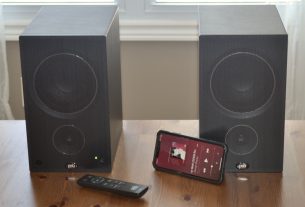It seems that where ever Hercule Poirot goes, people end up dead. Luckily he is a premiere investigator who uses his “little grey cells” to gather evidence, eliminate suspects, and then finally level an accusation. Now you have a chance to step into an Agatha Christie mystery and take on the roles of the suspect as well as the sleuth.
What Is Methodologie: Murder on the Links?
Methodologie: Murder on the Links is a social deduction card game for 3-6 players, ages 14 and up, and takes about 30 minutes to play. It’s currently available from your local FLGS, online retailers, and directly from Gray Wolf Games with a suggested retail price of $45 for a copy of the game. Gray Wolf Games offers free shipping in the United States and Canada as well. Methodologie: Murder on the Links was designed by Justin Waggle and published by Gray Wolf Games, with illustrations by Lea Ragos Segarra.
Methodologie: Murder on the Links Components
Here is what you get in the box:
- 18 Character cards
- 18 Location cards
- 18 Object cards
- 1 Character board
- 1 Location board
- 1 Object board
- 6 Player tokens
- 90 Target Tokens
- 1 Scoreboard
- 6 Score tokens
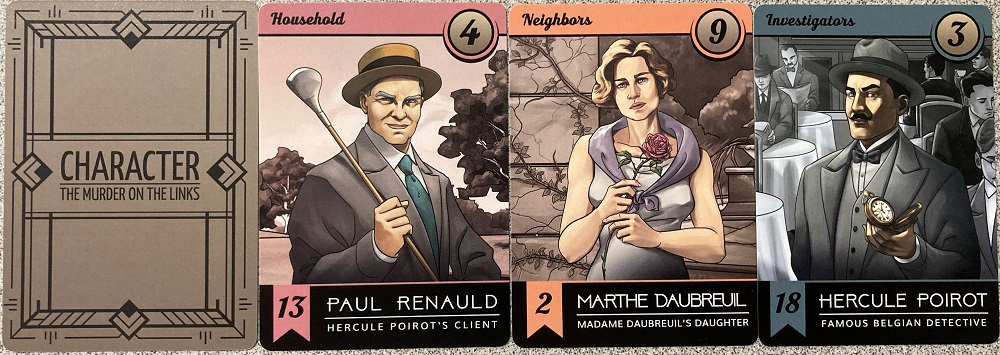
There is one character card for each of the 18 characters in the game. Any one of them could be the murderer. Each of the three types of cards has a variety of information. Across the top, the text and color show the card’s set. The number at the top right is the card’s point value while the number at the bottom left is the card’s numerical rank from 1 to 18, with 1 being the highest rank and 18 the lowest. The name of the card is across the bottom of the image and the smaller font text below the name describes more about that character.
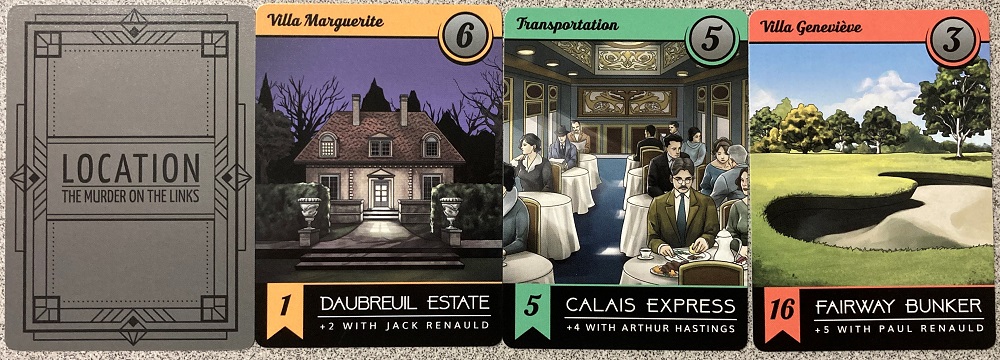
Location cards feature the 18 different locations in the game where the murder can take place. These cards have the same type of text and information as the character cards. However, below the name of the card is text describing the bonus points you can earn when this card is combined with the listed card.

Object cards represent weapons and other items in the game. These cards also have similar information on them just like the location cards.

The character, location, and object boards are used to eliminate suspects and other information needed to solve the murder. Each has images of the 18 cards of their type on them so players can see what cards have been removed from play and which are still out there in the player’s hands.
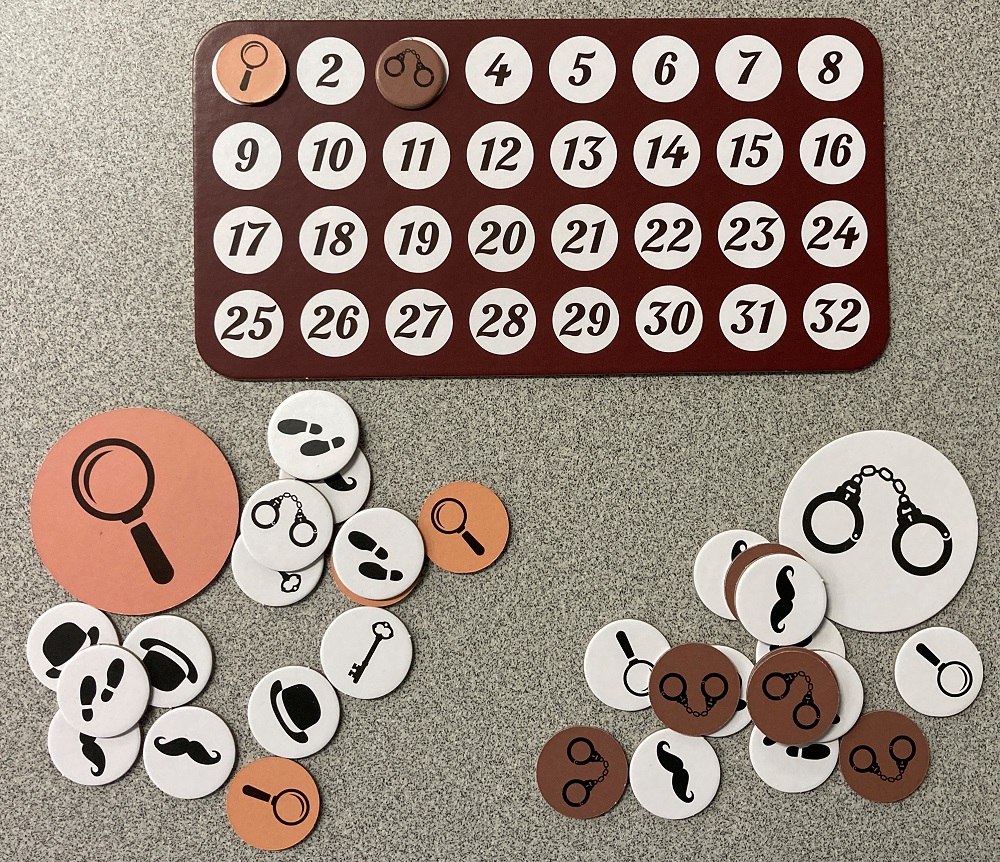
Each player has their own player token and other tokens matching the symbol on their player token. The scoreboard is used at the end of the game to calculate scores to determine who won the game.
How to Play Methodologie: Murder on the Links
The Goal
The goal of the game is to eliminate other players’ cards and score the most points at the end of the game.
Setup
Start off by unfolding and placing the three boards in the center of the table in the order of character, location, and then object. Each player selects a player token and then collects the 15 target tokens that match their symbol. Now sort the cards by their card back and shuffle them into three separate decks. Place the decks in the center of the table. Finally, deal each player 3 cards from each deck so everyone has nine cards. You are now ready to play.
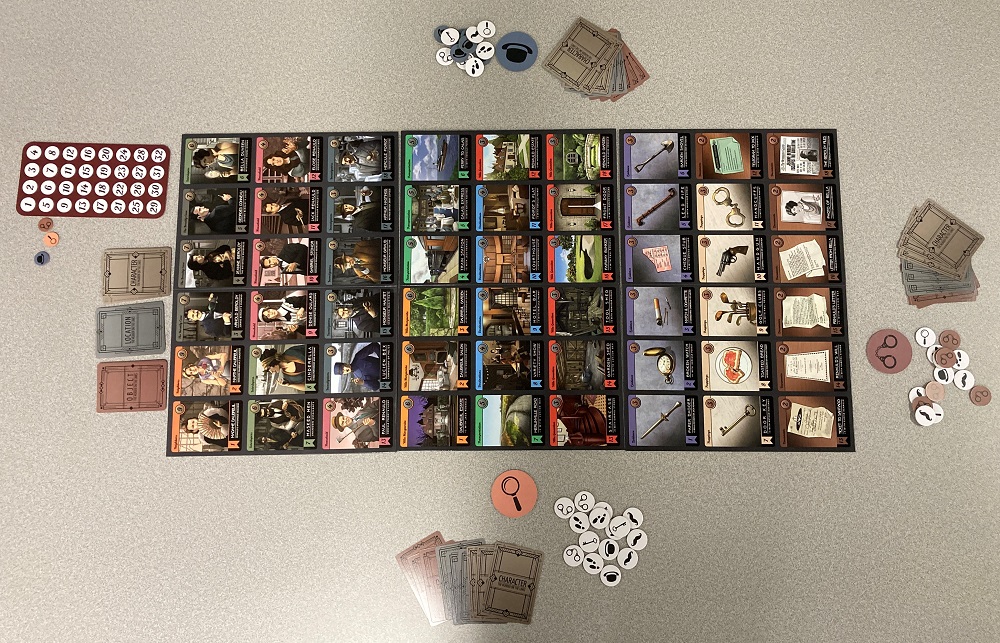
Gameplay
The game is played in two distinct phases: the Investigation Phase and the Accusation Phase. In the first phase, players reveal cards from their hands and interrogate each other to eliminate leads. During the latter phase, players make accusations against the cards remaining in the other players’ hands.
Investigation Phase
This phase is played in rounds with each round divided into four parts. At the start of the round, players present their evidence by selecting a certain number of cards from their hands. For 3-player games, each player chooses 3 cards each round. In four-player games, they choose 2 cards, and in 5- and 6-player games they only select one card. These cards are placed face down in front of the player, and when all players are ready, they reveal their cards simultaneously. It is important to note that players must keep at least one character, one location, and one object card in their hands at all times. If a player has 3 or fewer cards in their hand at this time, they cannot present evidence.
Next players may interrogate suspects. For each card type, the one who played the highest-ranking card of that type will conduct an interrogation, starting with characters. This begins with the interrogator asking the other players who have at least one card of the same set as the interrogator’s card. Players must answer truthfully by raising their hands. Any player who raises their hand becomes a suspect. The interrogator points at each suspect one at a time and asks them to reveal the identity of the card they have of that set. Each suspect must name one card from that set but does not have to answer truthfully. After hearing from all suspects, the interrogator may but is not required to perform a background check on one of the suspects. The interrogator points to that suspect and says “J’accuse!” The suspect must then reveal the card they claimed. If they lied, that card is eliminated. But if they told the truth, the interrogator must choose a card to be eliminated from their own hand instead. This step is repeated for location and then object. One player may be an interrogator more than once.
Now all cards played this round are eliminated by placing them face down over the matching spot on the three boards. This includes any cards eliminated by background checks as well.
Finally, starting with the player with the highest-ranking card, players draw cards to replace the ones they revealed as evidence. They do not draw cards to replace those lost in background checks. Players take turns drawing one card at a time from any deck and proceed in clockwise order. If a deck runs out of cards, then players can only draw from the remaining decks. After all three decks are out, no more cards can be drawn for the rest of the game.
Accusation Phase
When all players have three or fewer cards in their hand at the start of the Investigation phase, the Accusation phase begins. Any players with multiple cards of a single type must play cards face down until they have a maximum of one character, one location, and one object. During this phase, players will be one accusation against each opponent on each board, starting with a character and then going on to the location and then object.
To make accusations, players take one of their target tokens with another player’s symbol face up and then place it on which card they think the player still has in their hand. Once each player has placed one token for each other player on one board, do the same for the next board. After this is done, each player identifies which board space has the most target tokens with their player icon on them. That space represents the majority accusation against them. In case of a tie, the higher ranking space represents the majority accusation.
Each player now reveals and eliminates the indicated card from their hand if the majority accusation was correct. Place that card face down in front of the player. Once this is completed, continue to the end of the game.
Game End
The game ends when the accusation phase is complete. Now to calculate each player’s score. Each player reveals the remaining cards in their hand and scores the point values for each card as well as any bonuses. Cards eliminated during the accusation phase are not scored and do not count towards bonuses. Now everyone turns over their larger player token to show the colored side. Next check to see which target tokens were placed so that the symbol matches the card that the player still had in their hand at the end. Correctly placed target tokens are turned over to their colored side. Players score one point for each token that matches the color of their player token. Track all of the points on the scoreboard. The player with the highest score at the end is the winner. In case of a tie, the players have revealed accomplices and share the win.
Why You Should Play Methodologie: Murder on the Links
When I first learned of Methodologie: Murder on the Links, I was expecting something similar to Clue but with an Agatha Christie theme. I could not have been more mistaken. This game combines some unique mechanics that provide a fresh, new experience. Upon reading the rules for the first time, I was a bit confused as I tried to play through the game in my head. However, the rules are fairly simple and the best way to learn is just to play through a game with your friends or family. I like the strategy involved as you decide which cards to play during the investigation phase. Do you play high cards so you can interrogate suspects and try to get them to eliminate some of their cards, or do you try to save those high cards for the end so you can score them? As cards are eliminated, then players have to try to keep track of who may have the remaining cards so they are ready for the accusation phase when they place their target tokens to make their guesses. The gameplay keeps all players engaged in the game with little downtime. Since it only takes about 30 minutes to play the game, you can play a quick game in the evening or several games during a game night. I really enjoyed the game mechanics, the look of the game, and the strategizing required to win the game as well as the player interaction. For these reasons, I recommend Methodologie: Murder on the Links for those who enjoy social deduction games as well as something different with an interesting theme.
For more information or to purchase the game, visit the Methodologie: Murder on the Links webpage!
Click here to see all our tabletop game reviews.
![]() To subscribe to GeekDad’s tabletop gaming coverage, please copy this link and add it to your RSS reader.
To subscribe to GeekDad’s tabletop gaming coverage, please copy this link and add it to your RSS reader.
Disclosure: GeekDad received a copy of this game for review purposes.




